 |
 |
 |
| |
WEIGHT GAIN AFTER SWITCHING DIFFERENT INTEGRASE STRAND TRANSFER INHIBITORS (InSTIs)
|
| |
| |
CROI 2021 March 6-10 Reported by Jules Levin
Grace A . McComsey1, Paul Sax2, Keri N. Althoff3, Todd Brown4, Janna Radtchenko5, Helena Diaz-Cuervo6, Joshua Gruber7, Moti Ramgopal8, Steven Santiago9, Graeme Moyle10, Karam Mounzer11, Richard Elion5
1Case Western Reserve University, Cleveland, OH, USA, 2Harvard Medical School, Boston, MA, USA, 3Johns Hopkins University Bloomberg School of Public Health, Baltimore, MD, USA, 4The Johns Hopkins University School of Medicine, Baltimore, MD, USA, 5Trio Health, Louisville, CO, USA, 6Gilead Sciences, Madrid, Spain, 7Gilead Sciences, Inc, Foster City, CA, USA, 8Midway Immunology and Research Center, Fort Pierce, FL, USA, 9Care Resource, Miami, FL, USA, 10Chelsea and Westminster Hospital, London, UK, 11Philadelphia FIGHT, Philadelphia, PA, USA
Background: InSTIs are components of all recommended initial regimens. They have been associated with weight gain both in clinical trials and observational studies. TDF/FTC treatment has been associated with less weight gain than other NRTI pairs. Little is known about how individual InSTIs contribute to weight gain in real-world clinical practice while accounting for TDF-to-TAF switch or prior TDF.
Methods: The Trio Health HIV database was used in this retrospective study. Eligible patients (pts) were ≥18 yrs, suppressed at baseline (BL) and during study period (12 mo), switched to a new InSTI regimen (Jan'15-Jun'19), with weight measurements at BL and 12 (±3) mo. Univariate analyses [UV] were conducted using chi-square and t-test. Multivariable analyses (MV) using binary outcomes of gain ≥3, 5, and 10% (BL to 12 mo) were conducted using log binomial models adjusting for age, gender, race, BL BMI and CD4, pre-switch and post-switch drug class, individual InSTI (DTG, EVG, BIC), and TDF-to-TAF switch (sensitivity: pre-switch TDF).
Results: Of 2272 pts, 39% were prescribed EVG, 31% BIC, 28% DTG, 2% RAL (RAL excluded from MV). Of eligible pts, 64% received prior InSTI, 57% prior TDF; 47% switched from TDF to TAF. Pts differed in BL characteristics (p<.05): <50 years (EVG 56% vs 46% DTG); white (BIC 60% vs DTG 48%); black (DTG 40% vs EVG 30%, BIC 24%); female (12% EVG, 11% BIC vs 18% DTG, 27% RAL); CD4 <200 cells/mm (1%EVG,2%BICvs6%DTG,4%RAL). Pts had mean BLweight 84kg 3 (SD 17.6) and gained mean 1.3 kg (5.9): EVG 1.5 (5.4), BIC 0.9 (5.6), DTG 1.2 (6.5), RAL 1.9 (9.4). In UV, 41% of EVG pts vs 35% BIC gained ≥3%, p=0.015; 10% of DTG vs 6% of BIC pts gained ≥10%, p=0.046. There were no differences in gain by InSTI after controlling for BL characteristics, prior and current drug class, and TDF-to-TAF switch vs no TDF-to-TAF switch at all gain thresholds; TDF-to-TAF switchers were more likely to gain weight vs non TDF-to-TAF switch [Figure]. In sensitivity analysis accounting for pre-switch TDF (vs no TDF) there were also no differences in gain by InSTI type. Pts with prior TDF were more likely to gain ≥3% (aRR=1.2 CI 1-1.4) and ≥5% (aRR=1.4 CI 1.1-1.7) but not ≥10% (aRR=1.5 CI 0.9-2.4).
Conclusion: After accounting for pt characteristics and TDF-to-TAF switch or pre-switch TDF, there was no difference in weight gain ≥3, 5, 10% among different InSTIs. Future studies evaluating the effect of different InSTIs on weight gain should control for NRTI switches and demographics.
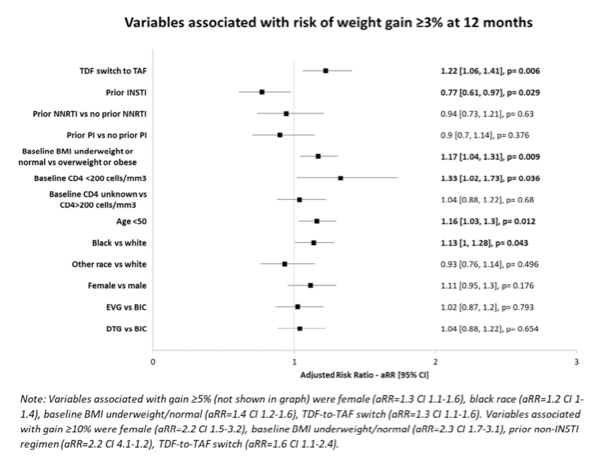
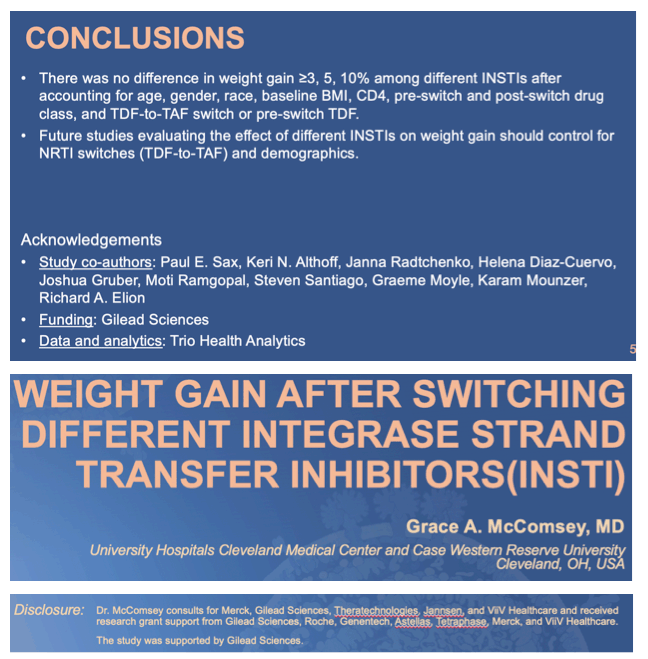
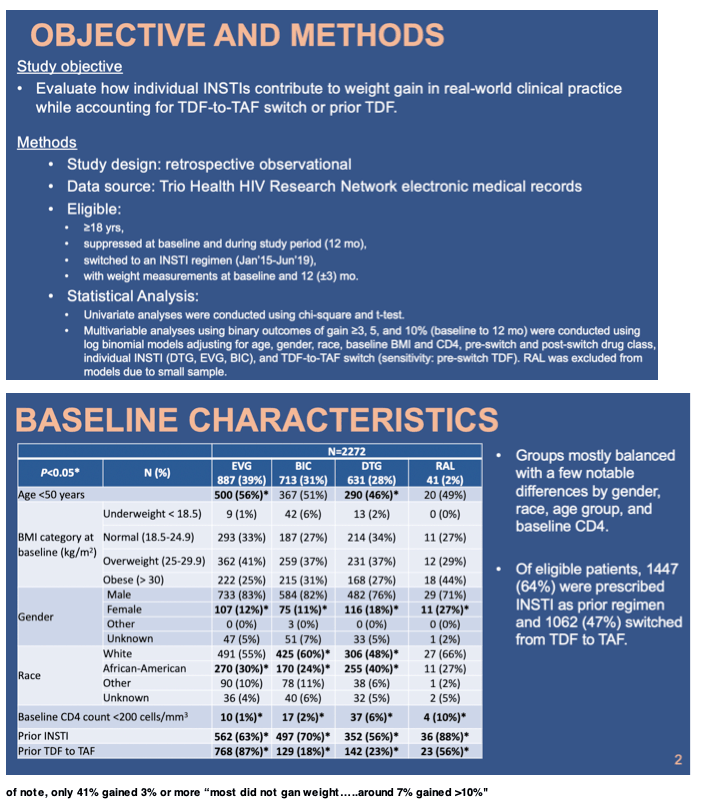
Of note, being female, underweight or normal BMI at baseline, black race showed up in all 3 models - 3%, 5% & 10% weight gain, as well, TDF to TAF switch showed up in all 3 models as associated with weight gain.
In the 3% & 10% gain groups being on a non-INSTI before & then switching to INSTI was associated with ore gain - 3% &10%.
The type of INSTI, which INSTI, was not associated with any difference in weight gain.
Dietary changes after significant weight changes has helped in their clinic by decreasing added sugar and saturated fat.
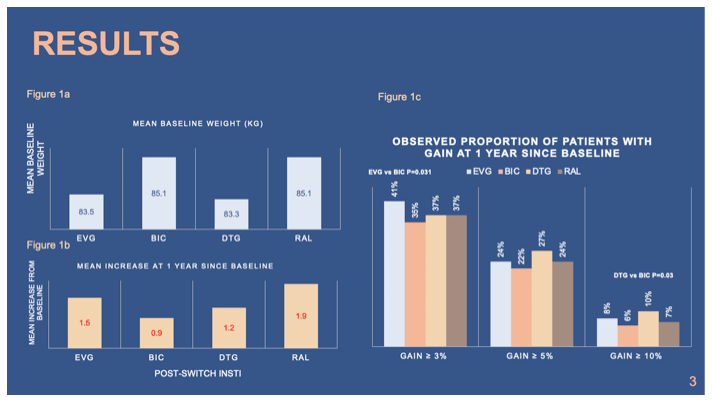
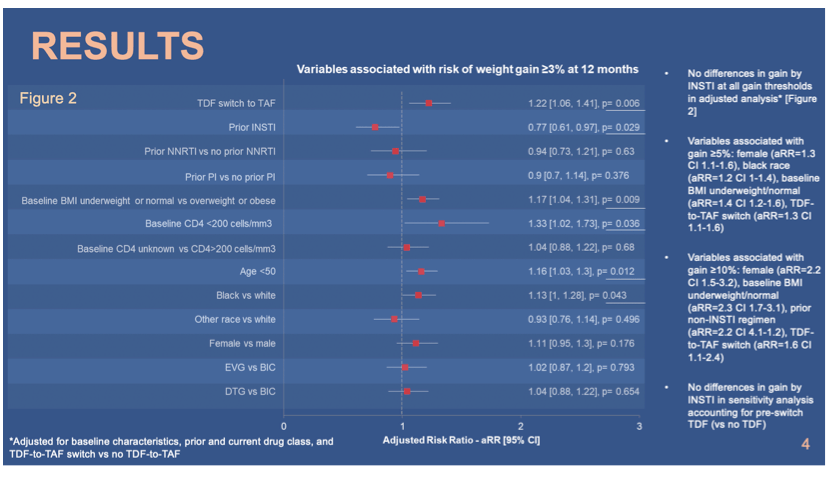
|
| |
|
 |
 |
|
|